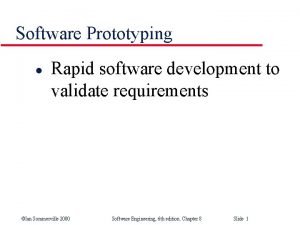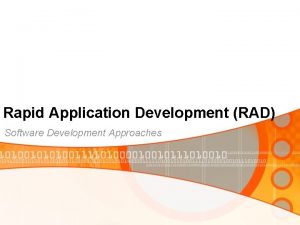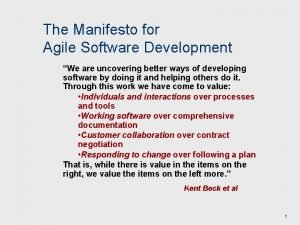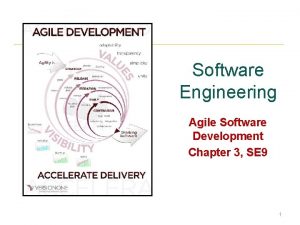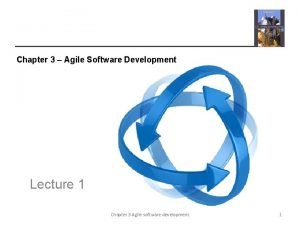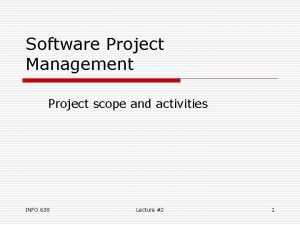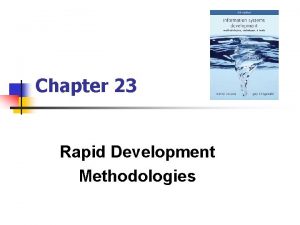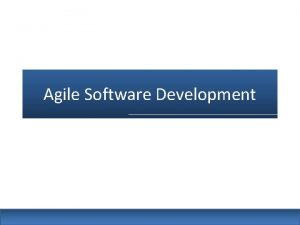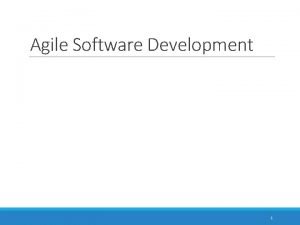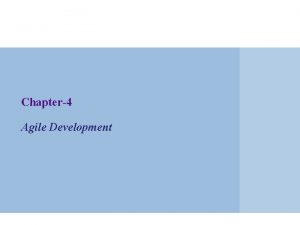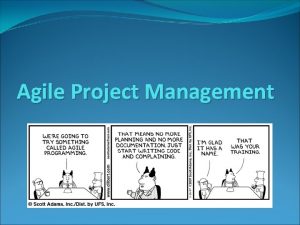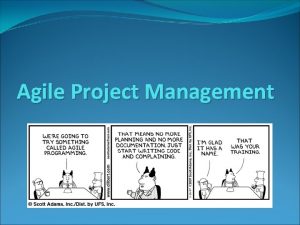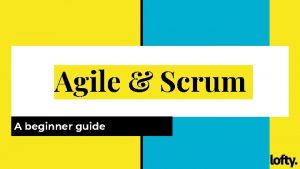Rapid software development 1 Topics covered Agile methods



























- Slides: 27

Rapid software development 1

Topics covered �Agile methods �Extreme programming �Rapid application development �Software prototyping 2

Rapid software development �Because of rapidly changing business environments, businesses have to respond to new opportunities and competition. �This requires rapid software development. 3

Requirements �Because of the changing environment, it is often impossible to arrive at a stable, consistent set of system requirements. �Therefore a waterfall model of development is impractical and an approach to development based on iterative specification and delivery is the only way to deliver software quickly. 4

Characteristics of RAD processes �The processes of specification, design and implementation are concurrent. There is no detailed specification and design documentation is minimised. �The system is developed in a series of increments. End users evaluate each increment and make proposals for later increments. �System user interfaces are usually developed using an interactive development system. 5

An iterative development process 6

Advantages of incremental development �Accelerated delivery of customer services. Each increment delivers the highest priority functionality to the customer. �User engagement with the system. Users have to be involved in the development which means the system is more likely to meet their requirements and the users are more committed to the system. 7

Problems with incremental development �Management problems � Progress can be hard to judge and problems hard to find because there is no documentation to demonstrate what has been done. �Contractual problems � The normal contract may include a specification; without a specification, different forms of contract have to be used. �Validation problems � Without a specification, what is the system being tested against? �Maintenance problems � Continual change tends to corrupt software structure making it more expensive to change and evolve to meet new requirements. 8

Prototyping �For some large systems, incremental iterative development and delivery may be impractical; this is especially true when multiple teams are working on different sites. �Prototyping, where an experimental system is developed as a basis formulating the requirements may be used. This system is thrown away when the system specification has been agreed. 9

Incremental development and prototyping 10

Conflicting objectives �The objective of incremental development is to deliver a working system to end-users. The development starts with those requirements which are best understood. �The objective of throw-away prototyping is to validate or derive the system requirements. The prototyping process starts with those requirements which are poorly understood. 11

Agile methods �Dissatisfaction with the overheads involved in design methods led to the creation of agile methods. These methods: � Focus on the code rather than the design; � Are based on an iterative approach to software development; � Are intended to deliver working software quickly and evolve this quickly to meet changing requirements. �Agile methods are probably best suited to small/mediumsized business systems or PC products. 12

Principles of agile methods 13

Problems with agile methods �It can be difficult to keep the interest of customers who are involved in the process. �Team members may be unsuited to the intense involvement that characterises agile methods. �Prioritising changes can be difficult where there are multiple stakeholders. �Maintaining simplicity requires extra work. �Contracts may be a problem as with other approaches to iterative development. 14

Extreme programming �Perhaps the best-known and most widely used agile method. �Extreme Programming (XP) takes an ‘extreme’ approach to iterative development. �New versions may be built several times per day; �Increments are delivered to customers every 2 weeks; �All tests must be run for every build and the build is only accepted if tests run successfully. 15

The XP release cycle 16

Extreme programming practices 1 17

Extreme programming practices 2 18

XP and agile principles �Incremental development is supported through small, frequent system releases. �Customer involvement means full-time customer engagement with the team. �People not process through pair programming, collective ownership and a process that avoids long working hours. �Change supported through regular system releases. �Maintaining simplicity through constant refactoring of code. 19

Requirements scenarios �In XP, user requirements are expressed as scenarios or user stories. �These are written on cards and the development team break them down into implementation tasks. These tasks are the basis of schedule and cost estimates. �The customer chooses the stories for inclusion in the next release based on their priorities and the schedule estimates. 20

Story card for document downloading 21

XP and change �Conventional wisdom in software engineering is to design for change. It is worth spending time and effort anticipating changes as this reduces costs later in the life cycle. �XP, however, maintains that this is not worthwhile as changes cannot be reliably anticipated. �Rather, it proposes constant code improvement (refactoring) to make changes easier when they have to be implemented. 22

Testing in XP �Test-first development. �Incremental test development from scenarios. �User involvement in test development and validation. �Automated test harnesses are used to run all component tests each time that a new release is built. 23

Task cards for document downloading 24

Test case description 25

Test-first development �Writing tests before code clarifies the requirements to be implemented. �Tests are written as programs rather than data so that they can be executed automatically. The test includes a check that it has executed correctly. �All previous and new tests are automatically run when new functionality is added. Thus checking that the new functionality has not introduced errors. 26

Pair programming �In XP, programmers work in pairs, sitting together to develop code. �This helps develop common ownership of code and spreads knowledge across the team. �It serves as an informal review process as each line of code is looked at by more than 1 person. �It encourages refactoring as the whole team can benefit from this. �Measurements suggest that development productivity with pair programming is similar to that of two people working independently. 27
 Rapid agile development
Rapid agile development Agile methods for embedded systems development
Agile methods for embedded systems development Accenture delivery methods focus areas
Accenture delivery methods focus areas What topics will be covered in this unit
What topics will be covered in this unit Rapid software development
Rapid software development Rapid application development disadvantages
Rapid application development disadvantages Rad software engineering
Rad software engineering Building agile business process - rapid apps
Building agile business process - rapid apps Msf for agile software development
Msf for agile software development Chapter 3 agile software development
Chapter 3 agile software development Agile software development cockburn
Agile software development cockburn Agile software development capitalization
Agile software development capitalization The manifesto for agile software development
The manifesto for agile software development Iso 9001 agile software development
Iso 9001 agile software development Chapter 3 agile software development
Chapter 3 agile software development Chapter 3 agile software development
Chapter 3 agile software development Seagile
Seagile Dtm rapid tool process
Dtm rapid tool process Using risk to balance agile and plan driven methods
Using risk to balance agile and plan driven methods Agile methods with trello
Agile methods with trello Software management activities
Software management activities Activities covered by software project management
Activities covered by software project management Activities covered by software project management
Activities covered by software project management Rapid development environment
Rapid development environment Lintindo
Lintindo Rad design workshop
Rad design workshop Agile product development for mass customization
Agile product development for mass customization Wisdm methodology
Wisdm methodology




